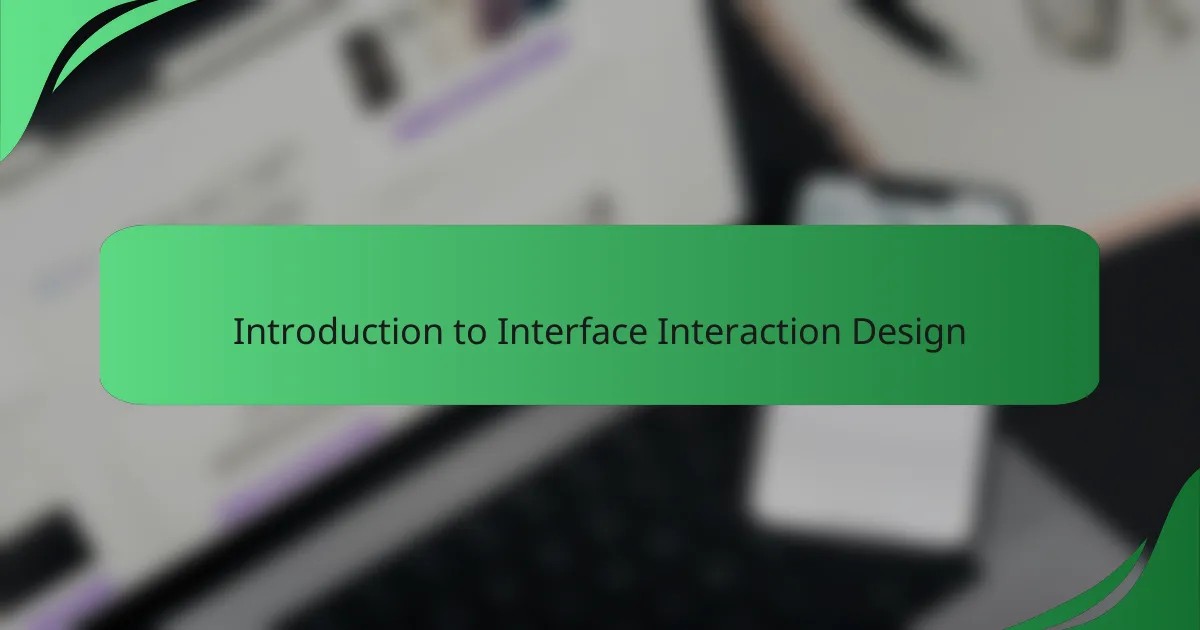Key takeaways
- Interface interaction design prioritizes user empathy, focusing on creating a seamless and intuitive experience.
- User feedback is essential for improving usability and engagement, allowing designers to address pain points effectively.
- Hotjar’s features, such as heatmaps and session recordings, provide valuable insights into user behavior and enhance design decisions.
- Implementing changes based on user feedback leads to significant improvements in user engagement and overall satisfaction.

Introduction to interface interaction design
Interface interaction design is more than just about aesthetics; it’s about creating a seamless experience for users. I still remember my first encounter with a poorly designed interface—it was frustrating! Those moments made me realize how essential intuitive design is for user satisfaction.
When I think about how users interact with a site, I often ask myself, “What do they truly want from this experience?” Understanding their needs and emotions is critical. It’s about empathy—how can we as designers place ourselves in the users’ shoes to enhance their journey?
Effective interaction design requires a careful balance between function and emotion. The right design can elicit joy, while a confusing one can provoke irritation. My journey in this field has taught me that every click, hover, and gesture matters deeply in ensuring users feel valued and understood.

Importance of user feedback
User feedback is crucial in interface interaction design because it directly informs how users experience a product. I’ve found that incorporating feedback can lead to significantly improved usability, which, in my opinion, translates to happier users. When I implemented changes based on real user comments, I noticed an immediate uptick in engagement, which was incredibly rewarding.
Listening to users not only helps in identifying friction points but also fosters a deeper connection with them. It feels rewarding to transform users’ struggles into smoother interactions, creating a sense of empathy in the design process. For me, this isn’t just about enhancing a product; it’s about crafting an experience that resonates with users on a personal level.
| Aspect | Importance of User Feedback |
|---|---|
| Identifies Issues | Helps locate usability problems early |
| Increases Engagement | Users feel valued when their opinions are considered |
| Drives Improvement | Encourages continuous refinement of the interface |

Overview of Hotjar features
Hotjar offers a suite of features that can tremendously enhance how you understand user feedback. As someone who has used these tools extensively, I found their heatmaps particularly enlightening. They visually represent where users click, scroll, and navigate on your site, allowing you to identify not only what attracts attention but also what gets ignored. This insight can be a game-changer for interface interaction design.
In addition to heatmaps, Hotjar provides valuable tools such as session recordings and surveys. I remember the first time I watched a session recording; it felt like stepping into my users’ shoes. This empathy experience helped me notice pain points and friction areas that I had previously overlooked. Here’s a summary of Hotjar’s key features:
- Heatmaps: Visual representations of user clicks, taps, and scrolling behavior.
- Session Recordings: Playback of real user sessions for in-depth analysis of their interactions.
- Surveys and Feedback Polls: Direct user input to gain insights on their experiences and needs.
- Conversion Funnels: Tracking user journeys to identify drop-off points in your design.
- Behavioral Analysis Tools: Tools that help you understand user flows and patterns.

Setting up Hotjar for feedback
Setting up Hotjar for feedback is a straightforward yet impactful process. I vividly recall the first time I integrated Hotjar into my website; it felt like unlocking a treasure chest of insights. After creating an account, I simply inserted the tracking code into my site’s header, and just like that, I was ready to start collecting valuable user feedback.
Next, I focused on configuring the feedback tools to suit my needs. By setting up surveys, I was able to ask users specific questions tailored to their interactions. I often ponder, how else can I connect with users? Through these short, strategically placed surveys, I discovered not only what users liked but also the nuances of their frustrations, which often provide the most actionable insights.
Additionally, I made sure to explore the settings for session recordings. Watching users navigate my site was like getting a front-row seat to their experience. Every click and hesitation illuminated paths I hadn’t previously considered. The real-time feedback transformed my design process, prompting me to think, “What can I do to make this journey smoother and more intuitive?”

Analyzing user behavior with Hotjar
When I first began using Hotjar, I was amazed at the depth of insights it provided into user behavior. The heatmaps were particularly eye-opening, showing me exactly where users clicked and how they navigated through my site. By analyzing this data, I could identify areas for improvement, leading to a more intuitive user experience.
Another feature that greatly helped was the session recordings. Watching real users interact with my site allowed me to empathize with their frustrations and confusion. It’s incredible how those snippets of real interaction prompted changes that I never would have considered otherwise.
Here’s a quick comparison table of some key features I found useful in Hotjar:
| Feature | Description |
|---|---|
| Heatmaps | Visual representation of user clicks, taps, and scrolling behavior. |
| Session Recordings | Playback of individual user sessions that show real-time navigation. |
| Feedback Polls | Quick surveys that gather user opinions on specific elements of the site. |

Implementing changes based on feedback
Implementing changes based on user feedback is where the real transformation happens. I remember when I gathered insights using Hotjar – it felt like having a window into my users’ minds. By analyzing heatmaps and session recordings, I identified confusing navigation paths that many users were struggling with. This experience reinforced how crucial it is to listen and adapt.
Once I had clear feedback, I prioritized changes that would have the most significant impact. The exciting part? Witnessing immediate improvements in user engagement after implementing these modifications. Here’s how I structured my approach:
- Prioritized common feedback themes.
- Created wireframes or prototypes for new design solutions.
- Conducted A/B testing to measure the effectiveness of changes.
- Engaged with users post-implementation to gather fresh insights.
- Continually iterated based on ongoing feedback.
Making adjustments isn’t just about fixing issues; it’s about enhancing the user journey, which brings immense satisfaction.



